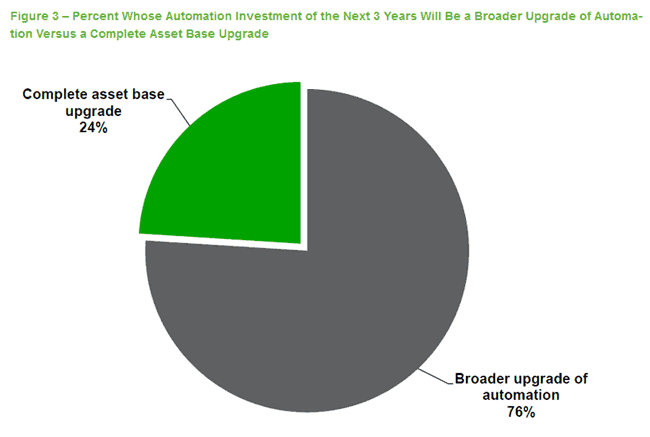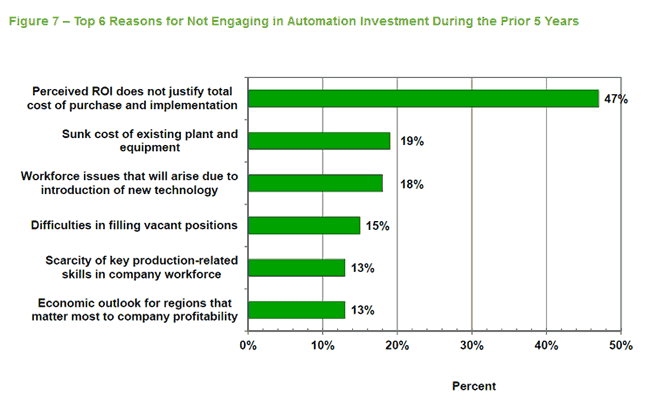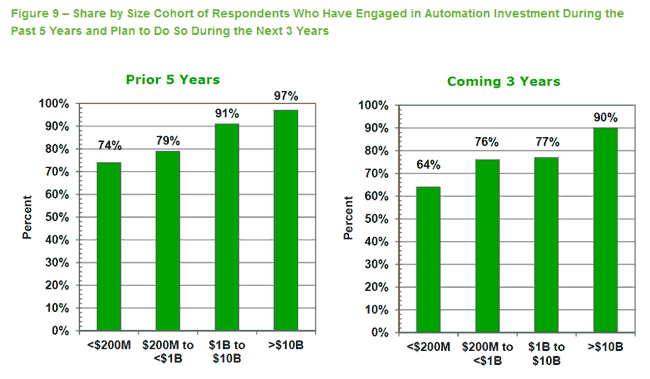From the earliest days, US manufacturers have looked to automation to reduce costs and increase throughput, but a combination of forces is driving companies to take that even higher both in recent years and those ahead.
Supply Chain Digest Says... |
 |
| The next report from MAPI in this series will examine how companies should measure ROI on new technology investments. |
 |
What do you say? |
| Click here to send us your comments |
 |
| Click here to see reader feedback |
|
|
So says a new study on US factory automation by MAPI, the Manufacturing Alliance, written by Cliff Waldman, Director of Economic Studies at MAPI. The report is based on survey responses from an unspecified number of US manufacturers.
Of course, the results from such a survey would depend on how – or even if – the term automation was defined , which in this case it was.
For example, the survey included this question: "During the past five years, has your company purchased and/or implemented one or more technologies that you have not used before, either for your US or non-US operations, whose purpose was to newly automate any aspect of your product-producing process through labor enhancement, labor substitution, or both?"
That obviously covers a lot of ground, from advanced robots to materials handling mechanization, but at least puts some context to the data.
Two somewhat more recent trends are driving automation interest, MAPI says. First, we are entering a sort of "post-Lean" manufacturing environment. MAPI says that "the Lean journey set only the framework for change, and is now moving to a second stage, with new technology and a new vision for what a factory looks like, how it operates, and what it actually does."
The second major automation driver is the aging workforce and resulting labor shortages that are developing in many parts of the world. Population and labor force growth are slowing not just in the advanced economies but also now in many emerging market nations, MAPI notes, indeed almost everywhere except India and most of Africa.
"Key countries in the developed and developing world are feeling the pressure of lower births, declining labor force shares of their total populations, and a swelling retirement cohort," MAPI says. This is naturally driving an interest in automation to reduce the need for factory floor workers.
The survey covered a significant number of data points, but we will just summarize a few of them here. First, under the definition provided above, almost all manufacturers are automating to some degree. The MAPI survey found 83% of US manufacturers had invested in automation in the past five years, and another 76% plan to do so over the next three years.
And about a quarter of that future investment will be significant. As seen in the chart below, 24% of respondents said their investments will be a complete asset base upgrade, versus 76% with more modest investment plans (we aren’t sure exactly what "Broader upgrade of automation" means, but it is clear from the report it is less ambitious that a full asset replacement).

Source: MAPI
(Article Continued Below)
|
CATEGORY SPONSOR: SOFTEON |
|
|
| |
|
|
What were the key factors in the companies that had failed to invest in automaton in the past three years? As shown in the chart below, lack of sufficient ROI, naturally, enough tops the list, followed by "sunk costs" of existing plant and equipment (which really shouldn’t be a factor, but regardless,) and concern about workforce issues from the new technology.

Source: MAPI
Interestingly, the next report from MAPI in this series will examine how companies should measure ROI on new technology investments and will discuss the most effective ROI metrics for evaluating the implementation of largely untested technologies. We are looking forward to that.
Finally, the analysis of the survey data broke out past and future automation investments by size of manufacturer. Virtually 100% of very large companies (revenues over $10 billion) have and plan to invest in automation, as seen in the chart below.

Source: MAPI
The numbers drop off a bit after that group, but still 74% of under $200 million companies have invested in the last five years, and another 64% plan to do so over the next three years.
SCDigest is actually a bit surprised the numbers drop off a bit for the planned investments versus recent activity, given the pressure it seems to automate today, but the decline could simply be a factor of the different time horizons (five years versus three).
The survey concludes by noting that we are "at a time when rampant automation with the current generation of emerging technologies is really a new phenomenon. In a sense, the current period is analogous to the computerization fad of the 1990s, although with the complicating difference of great heterogeneity, given the growing list of automation technologies."
It adds that "It will take time for the relationship between automation investment and productivity performance to be clarified."
The full report can be found here: Automation Investment in U.S. Manufacturing: An Empirical Picture
Is automation the phase for the "post-Lean" era? Is there really a labor shortage in the developed economies? Let us know your thoughts at the Feedback section below.
Your Comments/Feedback
|